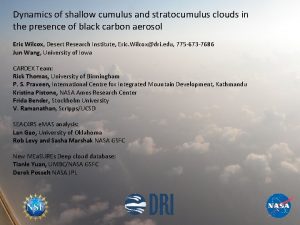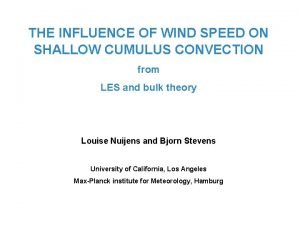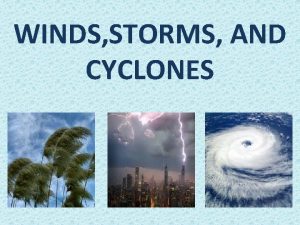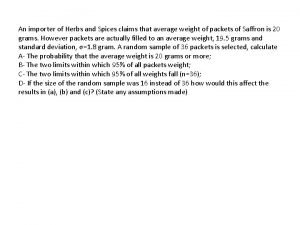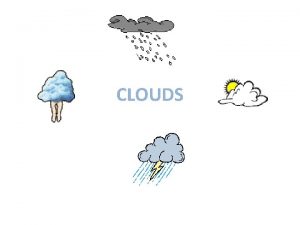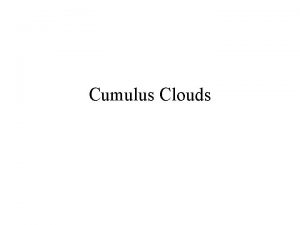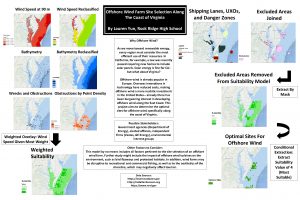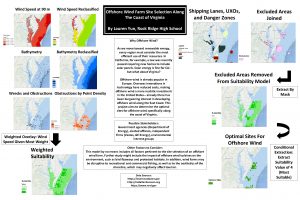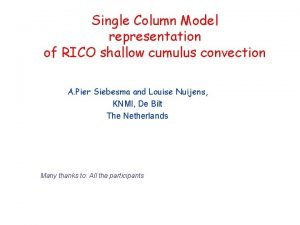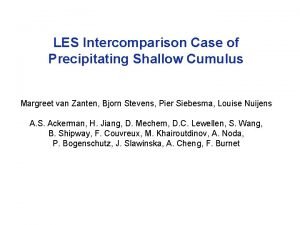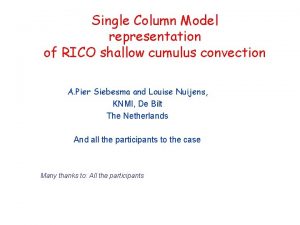THE INFLUENCE OF WIND SPEED ON SHALLOW CUMULUS












- Slides: 12

THE INFLUENCE OF WIND SPEED ON SHALLOW CUMULUS CONVECTION from LES and bulk theory Louise Nuijens and Bjorn Stevens University of California, Los Angeles Max-Planck institute for Meteorology, Hamburg

Outline • Why care about the trade winds? • RICO observations and simulations: disagreement? • An idealized framework • Large-Eddy Simulation set-up and results • Explaining the response to wind speed using bulk concepts • Summary and concluding remarks

Why care about the trade winds? The “trades” are defined by their winds, or perhaps by the constancy of the winds. When studying the meteorological structure of the trades, we often overlook the variability of the winds compared to other features. How does the strengthening (weakening) of the trade winds affect the processes and clouds within the air masses they advect? Nuijens et al. (2009)

RICO observations Nuijens et al. (2009) hypothesize that the moister profile represents an equilibrium response of the layer to stronger winds: “if the depth of the layer does not change, and the layer moistens and warms enough, surface fluxes may relax back to their original values”

RICO simulations § § Stronger winds lead to significant deepening, less evident moistening, and stronger surface moisture fluxes Interesting behavior emerges in the mass flux and cloud fraction, in the sense that they do not differ much

An idealized framework radiative cooling Qr subsidence warming and drying turbulent warming and moistening

LES set-up § § § Two cases without wind shear (initially), without rain microphysics and with idealized subsidence and thermodynamic profiles (thanks to Gilles Bellon) Resolution: Dx = Dy = 50 m, Dz = 25 m Domain: 12. 8 x 5 km Simulation time of 60 hours, then perturbed by d. U = +/- 5 m/s

LES results U 5 U 10 U 15

LES results

A “false” hypothesis? Are solutions possible whereby the layer does not deepen?

Wind speed influence in bulk models A two–layer shallow cumulus bulk model (Albrecht’s model - modified by Bretherton and Park, 2008)

Summary and concluding remarks § Wind speed should be acknowledged as a major forcing that may explain variability of clouds and precipitation in the trades. § In LES, stronger winds lead to larger surface moisture fluxes and an increase in the growth rate of the layer. Because the surface heat flux decreases instead, as more warm air is mixed in when the layer deepens, surface buoyancy flux and cumulus updraft velocity change little. Cloud (core) fraction and convective mass flux are also robust quantities. § A wind speed increase but zero deepening leads to an inconsistency in the energy budget of the layer. Clouds may resolve this inconsistency by deepening the layer. § Simple bulk concepts and well-known bulk models suggest that the deepening response is independent of the internal dynamics of clouds and how they mix with their environment. § Precipitation as well as the time-travelled through the trades may explain discrepancies between observations and simulations/models.
 Shallow cumulus
Shallow cumulus Shallow cumulus
Shallow cumulus Kurshalter
Kurshalter The increased wind speed is indeed, accompanied by a
The increased wind speed is indeed, accompanied by a A researcher claims that the average wind speed
A researcher claims that the average wind speed Weather chart symbol
Weather chart symbol Station model wind speed symbols
Station model wind speed symbols Emotions influence driving because they
Emotions influence driving because they Speed detection of moving vehicle using speed cameras ppt
Speed detection of moving vehicle using speed cameras ppt Speed time and distance formula
Speed time and distance formula Segala macam bentuk
Segala macam bentuk Stratus cloud meaning
Stratus cloud meaning Stratus cumulus cirrus
Stratus cumulus cirrus
